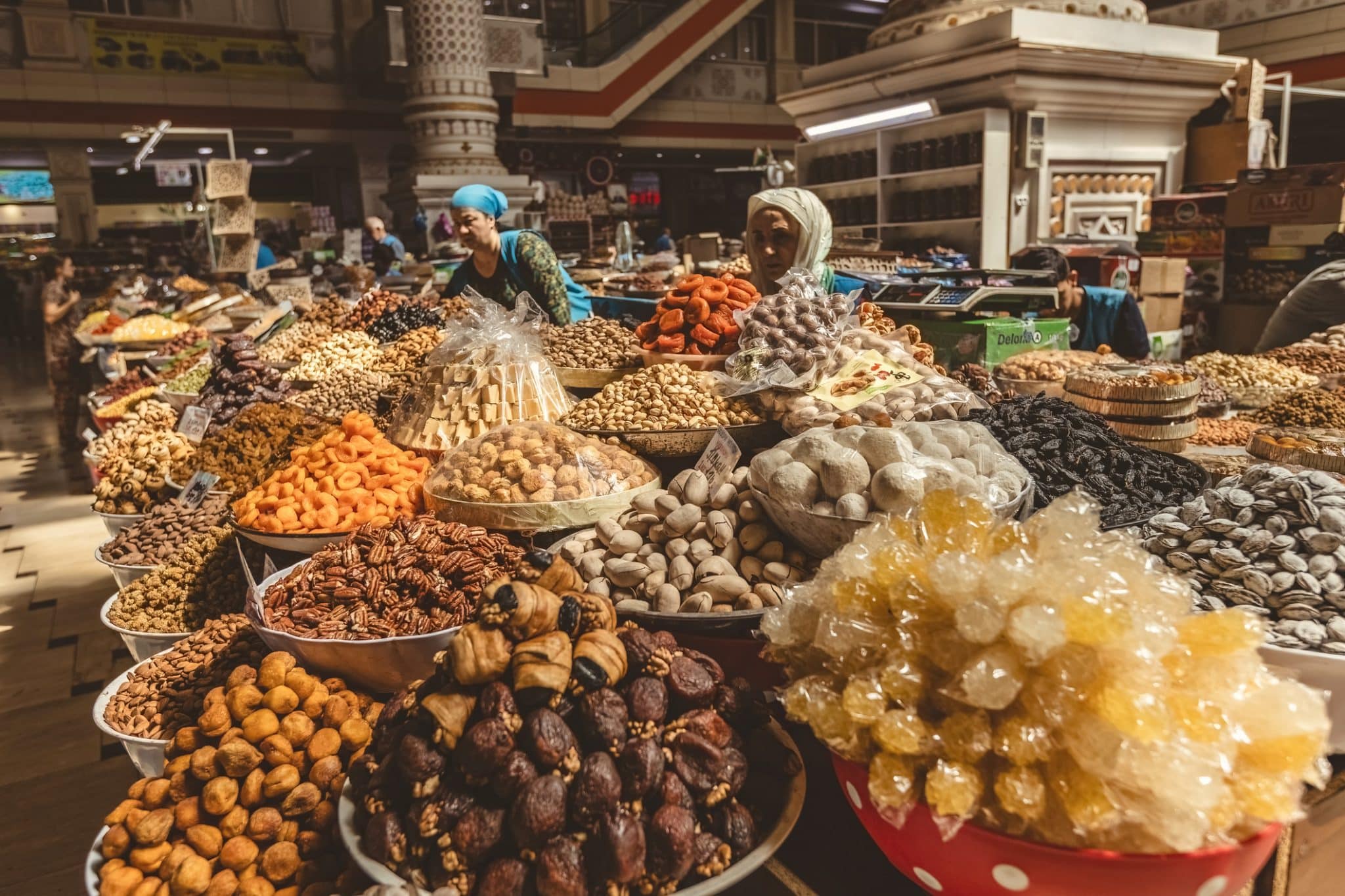Tajik cuisine draws influences from Persian, Turkic, and Afghan culinary traditions, as well as from the broader Central Asian steppe culture. Many dishes are held in common with Uzbekistan in particular. Of all the countries formerly a part of the Russian Empire and USSR, Tajikistan’s cuisine shows the least Russian influence.
The Tajik diet heavily on staples such as rice, bread, and dairy products, complemented by lamb or beef as the primary meats. Pork is never used in this heavily-Muslim country and chicken remain relatively quite rare. Although yak was once more common in the highlands, yak meat and milk now appear only occasionally and as a delicacy. Dishes are seasoned with saffron, anise, cumin, red pepper, and barberry, along with generous use of fresh greens like fennel, coriander, parsley, basil, mint, and green onions.
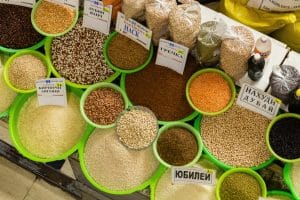
The small country’s highly varied geography has also created strong regional food traditions. In the Pamir Region, for instance, where small villages are isolated by extreme mountains, preserved foods, barley, peas, wild herbs, and offal are more common. Meanwhile, in the lowland Khatlon Region, melons, rice, spices, and apricots are more common. Names of foods can also vary across this varied and difficult geography.
Communal eating, traditional among many Farsi-speaking cultures, remains an enduring part of Tajik food culture. Particularly in rural areas, meals are often shared from a single large plate or bowl, and may be eaten with the hands. Certain dishes, such as qurutob, the Tajik national dish (see below), is traditionally eaten in this manner even in urban areas where the practice is now less common.
Tajik cuisine embodies nourishment and social connection as well as reflects the country’s long history, regional connections, and challenging natural environment.
Note: the Tajik language is written in Cyrillic script. The dishes below are listed alphabetically in the most common Latin script transliteration of those names. The original Tajik is listed in parenthesis at the end of each listing, with the standard English translation, when applicable.
Akhihc: (Dessert) Flour is slowly fried in oil and stirred continuously until it thickens into a porridge-like mass. After cooling, it is then kneaded by hand until its color changes from yellow to pale white. The result is a dense, slightly nutty-tasting sweet that is eaten in small portions, often with dairy. Time consuming and laborious, it is often prepared for family gatherings and weddings. The name differs slightly across regions. (Ахихц)
Alcohol: (Beverage) While beer, wine, and spirits are produced in Tajikistan, Tajikistan has long been Muslim and thus has no domestic tradition of alcohol consumption and no national tipple.
Asal: (Ingredient) Used as a sweetener, glazing agent, and in syrups, honey is a Tajik cultural staple. Major honey fairs showcasing different varieties from around Tajikistan are held and honey also features in Mehregan and the annual Melon Festival. Used in home remedies and many traditional deserts such as halva and chak-chak. Can be eaten plain with tea or spread on bread. Beekeeping and honey gathering is an important small-scale livelihood in some regions. (Асал; Honey)
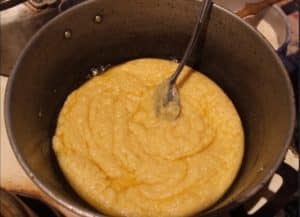
Bat: (Dessert) Wheat flour, oil, milk, and sugar are cooked to a sticky, dense consistency over a fire. It is then ladled into large, shared bowls. Bat is traditional for the holiday Batayom, for which it is named and which marks the coming spring. (Бат)
Barbaris: (Seasoning) Small red berries that are used to add a tangy-sour flavor. Often used in meat dishes and osh (see below). (Барбарис)
Belyash: (Bread) Deep-fried dough stuffed with minced meat. The dough is made from flour, yeast, milk, and sugar. It is left to rise, then cut into small circles, which are each filled with a mixture of raw minced meat, onions, and spices. The edges are then pinched, leaving a small opening atop the filling. The circles are then fried in oil. The result is something like a fluffy, meat-stuffed donut. (Беляш)
Boj: (Main Dish) For this thick grain-and-meat stew, chunks of lamb or beef meat or offal are simmered with grains until the mixture becomes porridge-like. The grains used will vary widely between regions, with some adding wheat, chickpeas, beans, lentils, and/or peas (any of which may be whole, crushed, or ground to flour). Any number of herbs might be added as well. The dish is known by many names, including dalda, kashk, gandumbaj, gandumjushak, farbech, guja, oshi kucha, etc. all names refer to essentially the same simple dish, although the specific ingredients and preparations may differ. Despite its simplicity, it carries rich symbolic meaning. In some areas, it is prepared for divination or fertility rites; in others, it is cooked in large quantities and shared among villagers as a wish for peace and prosperity. This relatively simple dish means many things to many people in Tajikistan. (Боҷ)
Bursoq: (Bread) Flour, eggs, milk, and baking soda are mixed to make a soft dough, which is then rolled out and cut into small square or round pieces and deep-fried. Bursoq is often served during holidays and special gatherings, usually with tea. (Бурсоқ)
Chagaldak: (Bread) A sticky, yeasted dough is prepared from flour, water, salt, eggs, and plenty of chopped herbs like cilantro, dill, and green onions. Once risen, it is rolled into balls and deep fried. They can be served with an array of dipping sauces from dairy based to tomato and spicy pepper based. (Чагалдак)
Chak-Chak: (Dessert) Flour, eggs, and a pinch of salt are mixed into a firm dough, which is then rolled out and cut into small strips or balls, which are then deep-fried. A syrup made from sugar and honey is poured over the crispy dough pieces. The mixture is shaped into piles or pressed into trays and left to cool and harden. It’s crunchy, slightly salty, and sweet. (Чак-Чак)
Chakka: (Dairy) Chakka is made by straining yogurt until most of the liquid drains out, leaving a thick, creamy, tangy product. It can be eaten on its own, spread on bread, or used as an ingredient in soups and sauces. Often paired with fresh herbs. (Чакка; Suzma)
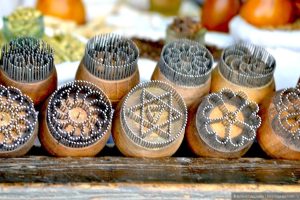
Chekich: (Food Preparation) These stamps, usually with wooden handles and metal spikes, are used in baking many types of bread. Sometimes pressed once into the very center, or used to around the whole interior, they create intricate patterns while also preventing the bread from rising. This results in crunchier or chewier loaf. Each region and family may have its own distinctive chekich design, making it both a practical utensil and a symbol of Tajik bread-making artisanry. Sometimes referred to as a muhpar. (Чекич; Мухпар)
Cholob: (Dairy; Beverage) Yogurt is mixed with cold water and a pinch of salt. It’s whisked or shaken until smooth and slightly frothy. Sometimes finely chopped herbs like dill or mint are added. Also known as “dugob” in some regions. It’s a cooling, refreshing drink, especially popular in summer or after a heavy meal. (Чалоб; Дугоб; Airan)
Choyi kabud: (Beverage) Loose green tea leaves are added to a teapot. Hot water is poured in and allowed to steep for a few minutes. Then, a special ceremony will see the tea poured into small drinking bowls and then back into the teapot. It is poured back to the bowls again, now with an even, consistent flavor, and served plain, usually without sugar, but sometimes with honey on the side. Often considered Tajikistan’s national drink, it is consumed especially during summer. Most tea in Tajikistan comes from China. (Чойи кабуд; Green Tea)
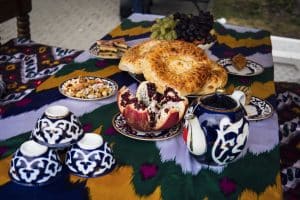
Choyi siyoh: (Beverage) Prepared the same way as green tea, but with black tea leaves (see choyi kabud, above). Sometimes sugar cubes or lemon slices are served on the side. Most popular in winter. (Чойи сиёҳ; Black Tea)
Damlama: (Main Dish) Damlama is a slow-cooked stew made by layering meat, potatoes, carrots, cabbage, and onions in a deep pot. The ingredients are cooked in their own juices with little or no added water. Flavored with cumin, black pepper, and fresh herbs, damlama has a rich, slightly sweet taste from the slow-cooked vegetables. It is a popular family dish, especially in autumn. (Дамлама)
Dried Fruits: (Snack; Dessert) Dried fruits such as apricots, raisins, prunes, figs, and dates hold a special place in Tajik cuisine, enjoyed both as standalone snacks and as ingredients that enhance various dishes such as pilafs, baked goods, and sweets. Dried fruits are a staple in Tajik tea culture, served alongside nuts, honey, and/or sweets.
Dumba: (Ingredient) Sheep tail fat is a prized ingredient broadly in Central Asian cuisine, but particularly valued in Tajikistan. Used for frying, flavoring pilafs, baking, and enriching meat or organ dishes such as dumba-jigar (see below), it is valued for its rich, distinctive flavor and high energy content. (Думба; Sheep Tail Fat)
Dumba-jigar: (Main Dish) After slaughtering a lamb, the dumba (tail fat) and jigar (liver) are cooked and served together. Liver is otherwise considered too dry, but with the tail fat, it becomes a delicacy enjoyed in Tajikistan and Uzbekistan. The two can be cooked on skewers, sauteed together, or boiled in salty water. Usually served with bread and, if boiled, the broth as well. (Думба-ҷигар)
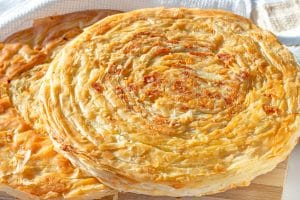
Fatir: (Bread) Flour, water, and salt are mixed into a soft dough, which is then rolled out thin, and brushed with melted butter, fat, or oil. Sweet or savory fillings can be added, with onion being particularly popular. The dough is then folded or rolled to create layers, and often shaped into a spiral before being baked on a flat griddle or in an oven. (Фатир)
Gandumoba: (Soup) This thick, rich soup starts with boiling offal including lamb hooves. Whole wheat grains (known as “gandum” in Tajik) are washed and soaked in water for several hours or overnight until very soft. They are then added to the broth and entrails with beans, chick peas, onions, chopped greens, and tomato paste. The cooked wheat and collagen from the hooves both add to the soup’s thickness. Considered a celebratory meal for events such as weddings. (Гандумоба)
Ghuz-xirvo: (Porridge) Nuts are ground into a powder and then boiled into a gruel. Some versions add flour or potatoes. Nutty, hearty, and slightly oily, ghuz-xirvo is a traditional mountain food of the Pamirs. (Ғуз-шурбо)
Gulfinjun: (Bread) Gulfinjun is a simple, ancient Pamiri side or snack made by pounding or grinding flatbread and with whole spring onions and nuts. A pinch of salt and a little oil or melted butter may be added as a binder. (Гулфинҷун)
Halal (Food Preparation): Halal means “permissible” in Arabic and refers to food and practices that are allowed under Islamic law. In Uzbekistan, with its significant Muslim population, halal foods are the norm. Meat must be sourced from animals that have been slaughtered in a specific, humane way while reciting a blessing. This practice reflects a deep respect for life and gratitude for the sustenance provided. Halal also requires the avoidance of alcohol, pork, and blood and generally emphasizes cleanliness, health, and ethical consumption.
Halvaitar: (Dessert) Many versions of the ancient and diverse sweet halva are available in Tajikistan, but halvaitar is considered the most uniquely Tajik variant. To make it, flour is fried in oil until golden, then hot syrup or honey is stirred in. The mixture thickens into a sort of pudding and is typically served in bowls, making it look like an orange soup. Sweet, dense, and with a slightly nutty flavor, it is often flavored with cardamom or nuts. Halvaitar is usually prepared during holidays and for large family gatherings. (Халва; Halva)
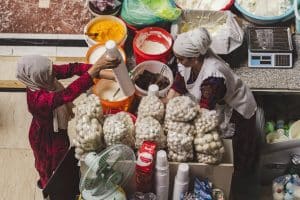
Jurghot: (Dairy) Thick, tangy yogurt made from cow or goat milk, often used as a base for sauces or eaten with bread. (Ҷурғот; Yogurt)
Kalapocha: (Soup; Main Dish) The head and hooves of a sheep or cow are cleaned and boiled for several hours. Sometimes tripe or other organ meat is added. Onions, garlic, and salt are added for flavor. Typically served with the rich, fatty broth and bread, kalapocha is a ceremonial dish served to honored guests, with the different parts of the head symbolizing wishes for better vision, hearing, and clarity of thought. (Калапоча; sometimes written Кала-поча)
Kazan: (Food Preparation) A kazan is a large cooking vessel traditionally made of cast iron and resembling a wok. It distributes heat evenly, it is typically used over an open flame to slow-cooking stews, soups, and fried dishes such as osh, bursoq, shurbo, damlama and many others. (Казан)
Khagina: (Main Dish) Beaten eggs are fried in oil or butter with chopped onions and sometimes tomatoes. Other additions like salt and pepper, peppers, chopped greens, and other spices can be added to taste. (Хагина)
Kompot: (Beverage) Dried or fresh fruits (such as apples, apricots, cherries, or raisins) are boiled in water with sugar. The mixture is simmered until the fruits soften and the liquid becomes sweet. It is either cooled and served immediately or sealed for winter. (Компот)
Kulcha: (Bread) Kulcha is a small, round bread made from flour, sugar, milk or water, yeast, and oil; often decorated with nigella seeds and marked with a chekich (see above). Often served with tea. (Кулча)
Lagman: (Main Dish) Hand-pulled or -cut noodles are topped with a kazan-cooked (see above) mix of beef or lamb, onions, bell peppers, tomatoes, and garlic. Cumin and black pepper are common seasonings and fresh cilantro or dill is added at the end. (Лагман)
Lubiyeva: This signature bean soup from the Rasht Valley consists mostly of beans cooked in bone broth. Coarsely ground wheat and sugar beet tops are added, sometimes with tomatoes. The soup is finished with fried onions, parsley, and celery. (Лубиёва)
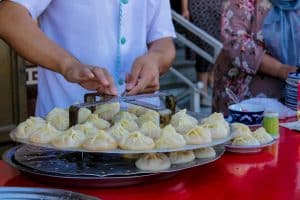
Mantu: (Main Dish) These steamed dumplings are made from a thin flour, salt, and egg dough. The most common filling is spiced, minced lamb or beef mixed with finely chopped onions, but might also contain pumpkin, beans, or potato either as a vegetarian option or as a mix-in with the meat. Served with melted butter or yogurt. (Манту)
Mastova: (Soup) To a thick ragu of meat, onions, carrot, potato, peppers, and/or tomatoes, water, rice, and seasonings such as coriander and cumin are added. It is served topped with chopped greens and a generous amount of jurghot (see above). (Мастова)
Navat: (Dessert) Navat is literally just crystallized sugar. It forms beautiful, yellowish shapes and is usually sold on strings or sticks that can make an excellent souvenir to take home. It is often enjoyed, especially by children, as a treat consumed like a lollypop or hard candy. It can also be dipped into tea to sweeten and flavor the beverage.
Nishollo: (Dessert) A thick, marshmallow-like dessert, nishallo is made from egg whites, beaten with syrup slowly added until it achieves a thick, glossy foam. Sometimes soapwort or another foaming agent is added to speed the process. Sometimes rose water, licorice, anise, or lemon juice is added for flavor. Light, airy, sweet, and highly labor intensive, it’s associated with major celebrations like weddings and Navruz. (Нишолло)
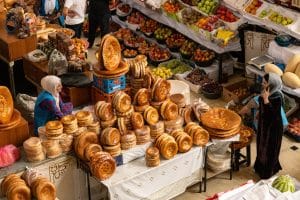
Non: (Bread; Ingredient) Bread occupies an ever-present, near-sacred place on Tajik tables. Each Tajik citizen eats, on average, 10 kilograms of bread per month. Custom states that bread cannot be thrown away, must be broken by hand and never cut with a knife, and never placed face down. Served with almost every meal, it is also used in the creation of other dishes. Payova sees onions boiled in saltwater poured over bread. Qimoch-tarit adds salt water and oil to bread. Gulfinjun (see above) is a side made from bread ground with nuts and onions into a paste. Meanwhile, for khom-nigul, crumbled bread is added to boiling milk, crushed nuts, and chopped onions to make a porridge. Even the Tajik national dish, qurutob, (see below) has bread at its base. (Нон; Bread)
Noni Chazdor: (Bread) This rich bread is made by kneading small pieces of fat (especially dumba (see above)) into the dough before baking. As the bread cooks, the fat melts, leaving the bread soft, flavorful, and filling. Served especially during cold months. (Нони чаздор)
Noni Tandoori: (Bread) Flour, water, salt, and yeast are mixed to make a soft dough. Once risen, it is formed into round discs and marked with a chekich (see above). Baked in a tandoor (see below), it is chewy loaf with a crusty exterior. This is the most common bread in Tajik culture and throughout Central Asia. (Нони тандури)
Noshkhukhpa: (Dessert) Noshkhukhpa is a warm fruit dish made by boiling dried apricots until they soften and then mashing them. Sometimes it is sweetened with sugar and/or thickened with flour. Tangy and slightly sweet, it was traditionally eaten in winter as both a treat and a remedy against colds. (Ношхахпа)
Orzuq: (Bread) One of the most beloved pastries in Tajik cuisine, orzuq is often made from the same dough as fatir (see above) or a simpler dough resembling a thick pie crust. In either case, the dough is rolled out to about an inch thick, stamped with a chekich (see above) around the center, cut into diamond-shaped strips, and deep fried. These can be served plain, lightly salted, or dusted with powdered sugar. (Орзуқ)
Osh: (Main dish) Also known as “palov” in Tajikistan, this rice-and-meat dish is Central Asia’s most popular regional food and can be found on nearly every holiday table in Tajikistan. Onions, carrots, and meat (lamb or beef) are fried in a kazan (see above). Then, water is poured in to cover, once the liquid has reduced, rice is added on top, leveled, and the pot covered. It is left to steam on low heat until the rice is fully cooked. Once ready, the rice, carrots, and meat are gently mixed before serving. Variations can differ by region and might include dried fruits, chickpeas, or hard-boiled eggs. In the Tajik capital of Dushanbe, “Markazi Osh” is a massive osh center where various kinds are served. (Палов, Ош)
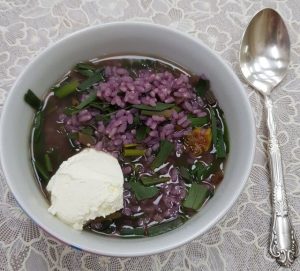
Oshi Siyohalaf: (Soup) This spring soup is made from siyohalaf, a wild mountain onion native to Tajikistan whose name translates to “black grass.” It is particularly rich in vitamins and is believed to both fortify the body and treat all manner of ailments. The soup is simple – siyohalaf is boiled in salty water and will turn it black. Cooked rice is then added and allowed to absorb the black liquid. The dish is then finished with chakka (see before eating. (Оши сиёхалаф)
Oshi Burida: (Soup) Oshi burida is typically eaten as a meal. Greens, onions, chickpeas, and beans are boiled. Fresh-cut pasta, which can be made from wheat or pea flour, is then added. The dish is finished with salty jurghot or thinned chakka (see above). In some areas, in a variation of the dish known as imoch (имоч), flour is directly added to the soup instead of noodles, making it more of a porridge. (Оши бурида)
Oshi Tuppa: (Soup) Noodles are prepared fresh from flour, egg, salt, and water and cut into strips. Lamb or beef is fried with onions and then simmered with chickpeas and turnips, with the broth enriched with tomato paste, black pepper, and bay leaf. The noodles are added near the end of cooking and the soup is finished with a generous helping of fresh, chopped greens. (Оши туппа)
Parvarda: (Desert) Sugar is boiled with citric acid, stretched to a tube, cut to small pillow shapes, and rolled in flour. Various flavors can be added from lemon, barberry, rose water, and various fruit or berry juices. A related sweet, pishmak (sometimes called “pashmak”) is made by continually twisting and pulling the candy in the tube state, causing the sugar to form fine threads similar to cotton candy. (Парварда)
Pudina: (Seasoning) Pudina, fresh or dried, is used for salads, tea, yogurt-based sauces, and some beverages. (Пудина; Mint)
Qaroqurut: (Dairy) A dark, intensely tangy variety of qurut (see below), made by further drying or toasting the strained yogurt until it hardens and turns nearly black. It has a strong, salty-sour flavor and is often grated or dissolved into soups and stews as a seasoning. In mountainous regions, qaroqurut is valued for its long shelf life and concentrated nutrients. (Қароқурут)
Qaymoq: (Dairy) This rich dairy cream is created by boiling milk, allowing it to cool slowly, and collecting the thick layer of cream that forms on the top. It’s often eaten with bread or added to tea. (Қаймоқ)
Qurut: (Dairy) Yogurt is firmly strained until all liquid is removed, then salt added. The mixture is formed into balls and left to dry in the sun or food dehydrator. Hard, light, and salty, they can last for months and travel well. They are eaten plain or dissolved in water to make soups, drinks, or sauces. (Қурут)
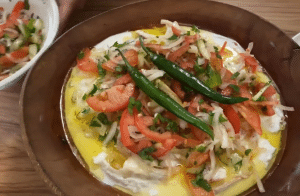
Qurutob: (Main Dish) Known as the national dish of Tajikistan, this dish is traditionally vegetarian and prepared in several stages. First, qurut (see above), from where the dish derives its name, is dissolved in warm water to form a tangy, salty sauce. Thin pieces of fatir (see above) are torn and spread in a large communal dish, then softened with the qurut liquid. It is topped with fried onions, fresh tomatoes, cucumbers, and generous handfuls of various chopped herbs. Sometimes called “Shakarob” in some regions, it can be topped with fried lamb for special occasions. (Қурутоб)
Samanak: (Dessert) Made only for Navruz, this dish is made from wheat grains that have been kept damp for several days and allowed to sprout. These sprouts are then ground and strained to get a sweet, milky liquid that is mixed with flour and cooked slowly for many hours, sometimes overnight, while being constantly stirred. The final dish is thick, brown, and naturally sweet. (Cуманак; Sumalak)
Sambusa: (Main Dish) Dough, made with flour, water, salt, eggs, and butter is rolled out, cut into triangles or squares, and stuffed with minced meat, chopped onion, salt, and sometimes chunks of fat. Baked in a tandoor (see below) or regular oven, it is a popular street food and made at home. (Самбуса; Samsa)
Seb: (Ingredient; Snack) Apples are an important crop in northern Tajikistan, grown in wide variety and celebrated at autumn festivals. Eaten fresh, dried, or made into juices or jams, they can also be used as a sweet-tart counterpoint in some meat dishes. (Себ; Apple)
Sekh-Kabob: (Main Dish) Chunks of lamb or beef are marinated in onion, salt, and sometimes vinegar or lemon juice. They are then placed on metal skewers (known as “sekh”) and grilled over hot charcoal. Also sometimes known as “shashlik,” the dish is typically served with sliced, marinated onions and bread. (Сех-Кабоб, Шашлик; Shish Kebab)
Sorbet: (Beverage) Sugar is dissolved in water with lemon juice, mint, or rose water for flavor. Sometimes fruit juice, berries, cinnamon, or honey are added as well. The drink is chilled and served cold. It’s sweet, light, and often served during hot days or at weddings. (Сорбет)
Shirchoy: (Beverage) Milk is boiled and mixed with black tea. Salt is added and sometimes butter or cream. Served warm in small drinking bowls, often alongside bread or dried fruits. (Ширчой)
Shirkadu: (main dish) Pumpkin is boiled in lightly salted water until soft, then mashed. It is then simmered in milk, often with both sugar and salt added. Often eaten for breakfast. (Ширкаду)
Shavla: (Main Dish / Soup) This dish resembles a much softer version of osh (see above). Meat is fried with onions and sometimes carrots, tomatoes, and chickpeas. Then, water and rice are added and mixed. Also known as shovla or shula, the consistency can be porridge-like or soup like, depending on the region and amount of water added. (Шавла, шовла, шула)
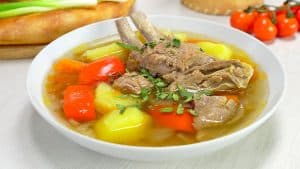
Shurbo: (Soup) Chunks of meat (lamb or beef), potatoes, carrots, and onions are placed in a pot. Water is added, and the soup is brought to a boil, then simmered for a long time. Salt and herbs like parsley or dill are added near the end. Sometimes known as “shurpa” and “khomshurbo.” (Шурбо, Хомшурбо)
Suxat-thod: (Stew) When cattle are slaughtered, the lungs, liver, and sometimes the heart are taken and fried in oil, usually with onions and/or potatoes. A celebratory meal usually shared with guests. (Шушҳо ва ҷигар)
Tandoor: (Food Preparation) This clay or brick oven is widely used in Tajik cooking. Heated with burning wood or coal, its shape creates high temperatures that allows bread like non (see above) to cook quickly while stuck to the oven’s inner walls. Meat dishes, such as tandyr lamb, are also prepared in this oven, developing a crispy exterior and tender, juicy interior. (Тандур)
Tarbuz: (Ingredient, Snack) Melons are a pride of Tajikistan. Consumed locally and a major export, they are celebrated in melon festivals as they are harvested. Various varieties will ripen throughout summer and early fall, with about 70 varieties of melon and 15 watermelon (kharbuza) varieties grown. They are eaten raw, but preferably chilled, and usually plain. Melon can also be dried for preservation, producing leathery, pungent strips. Melons are particularly associated with warmer, lowland regions like Khatlon. (Тарбуз; Харбуза)
Tuhp: (Dairy) Kefir is strained through a cheese cloth and then left to dry. The result is a hard, light brown mass that, when fully dry, can be safely stored for two to three years. It can be eaten plain or reconstituted into various recipes. Most associated with the rural, mountainous Gorno-Badakhshan Region. (Тухп)
Tut: (Ingredient, Snack) Mulberry trees thrive in Tajikistan and mulberries are one of the most common fruits of the Pamirs. They ripen in late spring or summer and are often eaten fresh right off the trees. They are also made into jam and juice and used as a sweetener in many dishes. Dried mulberries are cooked down to dense, sweet, rich paste known as piht for preservation, use in other recipes, and given to children as a favorite treat. Piht can be additionally be fortified with nuts, flax seeds, and other ingredients to enrich its taste and nutritional value.
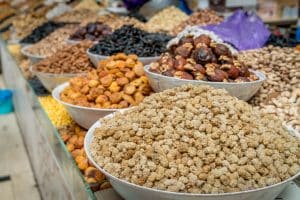
Zardolu: (Ingredient; Snack) Apricots are another food considered almost sacred in Tajikistan. Consumed in abundance locally and an important export, more than 180 varieties of the fruit are grown in Tajikistan, where cutting down an apricot tree requires special government permission. Apricots are consumed both fresh, dried, and in various recipes and traditional medicines. The flesh is believed to be useful in remedying colds, fortifying the immune system, and an antidiuretic. The kernel, which should be cooked or toasted before consumption in moderation, is almond-like and rich in antioxidants and used to treat constipation.
Zira: (Seasoning) Cumin is one of the most widely used spices in Tajikistan, appearing especially in plov, soups, and meat dishes. (Зира; Cumin)
You’ll Also Love
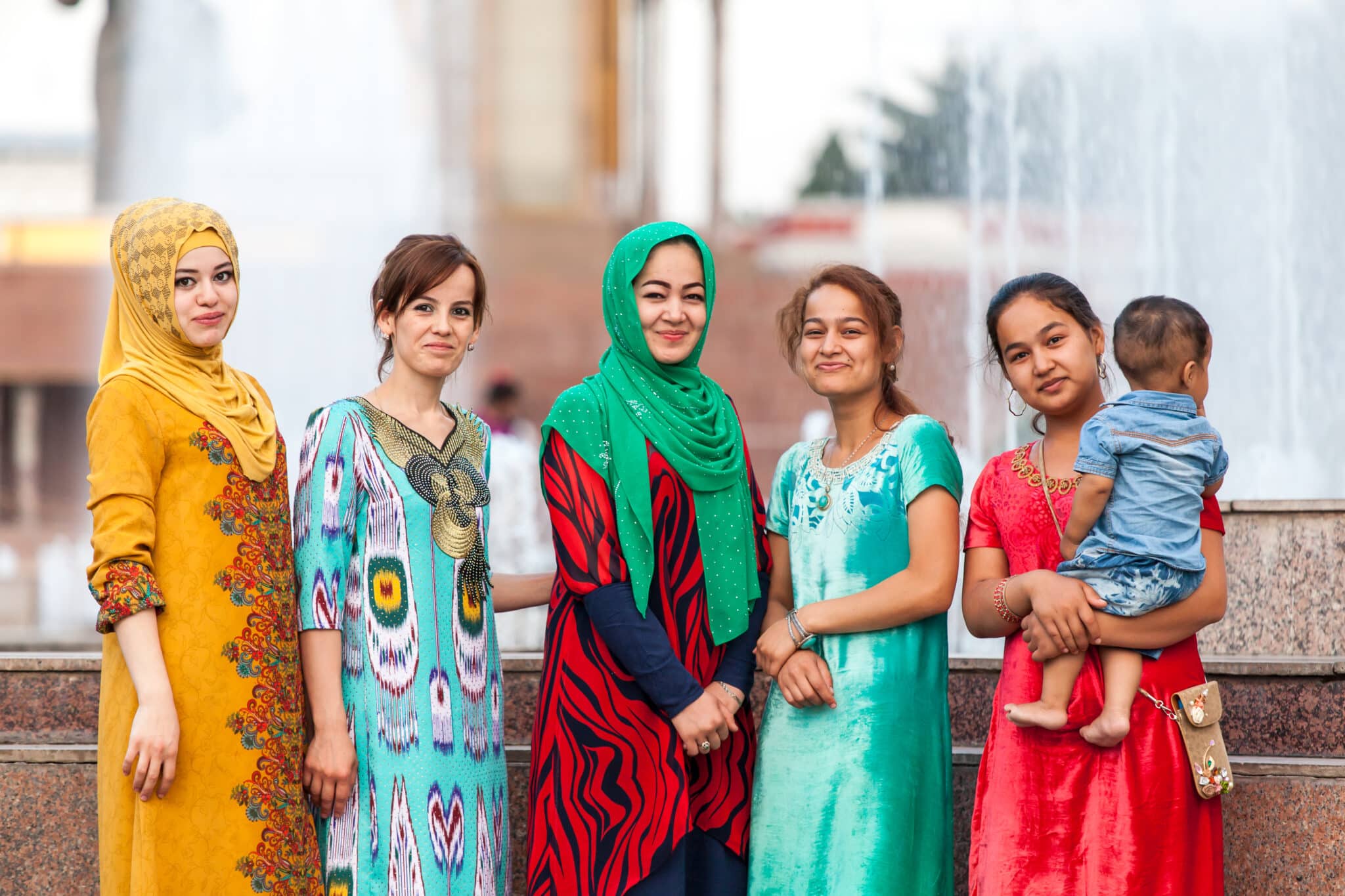
The Talking Tajik Phrasebook
The Talking Phrasebook Series presents useful phrases and words in side-by-side translation and with audio files specifically geared to help students work on listening skills and pronunciation. Below, you will find several useful phrases and words. To the left is the English and to the far right is the Tajik translation. Tajik uses a Cyrillic […]

World Nomad Games
The World Nomad Games is a unique international sporting event that celebrates the traditional sports and cultural heritage of the traditionally nomadic Turkic people. The World Nomad Games brings together athletes and spectators from around the world to participate in nomadic traditions through a festival of traditional sports, cultural events, and art exhibitions. The next […]
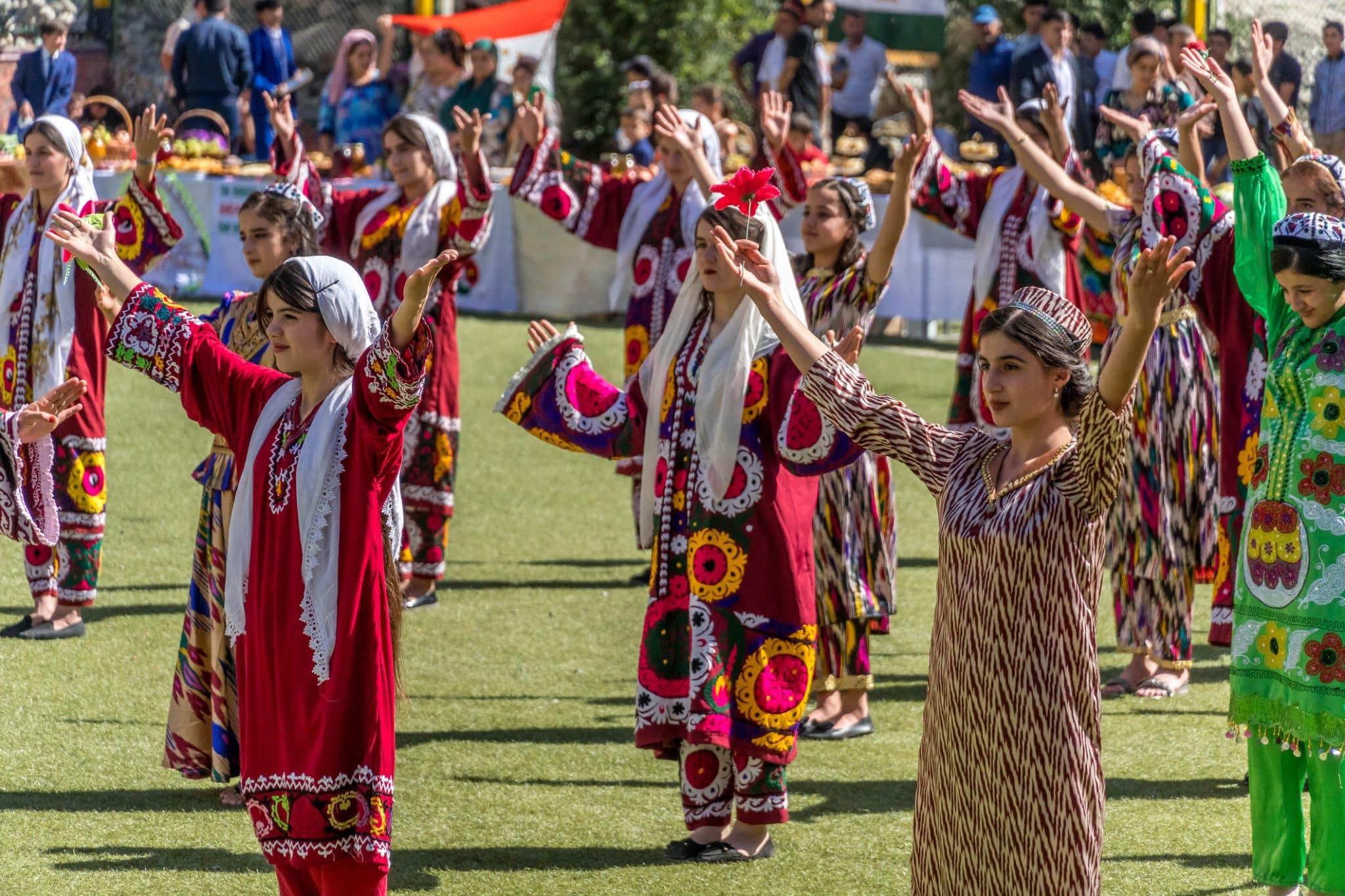
Tajik Holidays 2025: A Complete Cultural Guide
Tajikistan’s holiday calendar is a vibrant reflection of the modern country. These holidays blend ancient Persian traditions and Islamic observances with Soviet legacies and contemporary patriotism. Celebrations of unity run deep in this calendar, both as a reflection of shared labor and support in ancient rural life to a healing process as country recovers from […]
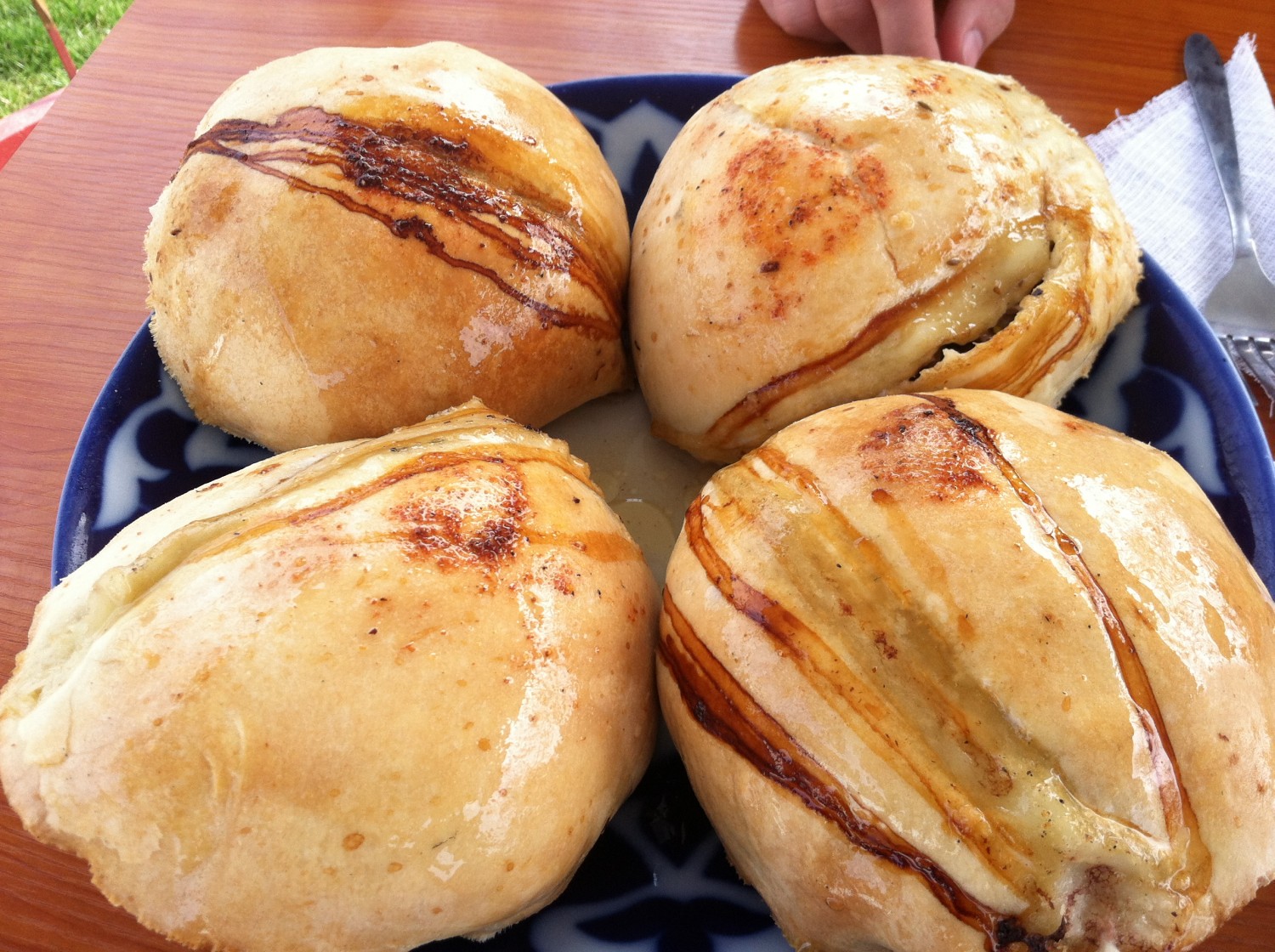
Samsa: A Tasty Pastry of the Silk Road
The samsa (самса) is a meat- or vegetable-filled savory pastry. They are both flaky (слоеная) and crispy (хрустящая). They are enjoyed across the former USSR, where they are most associated with Central Asian cuisine. The samsa originated in the Middle East and spread across the Silk Road (Шелковый путь), reaching Central Asia, India, and Africa. […]
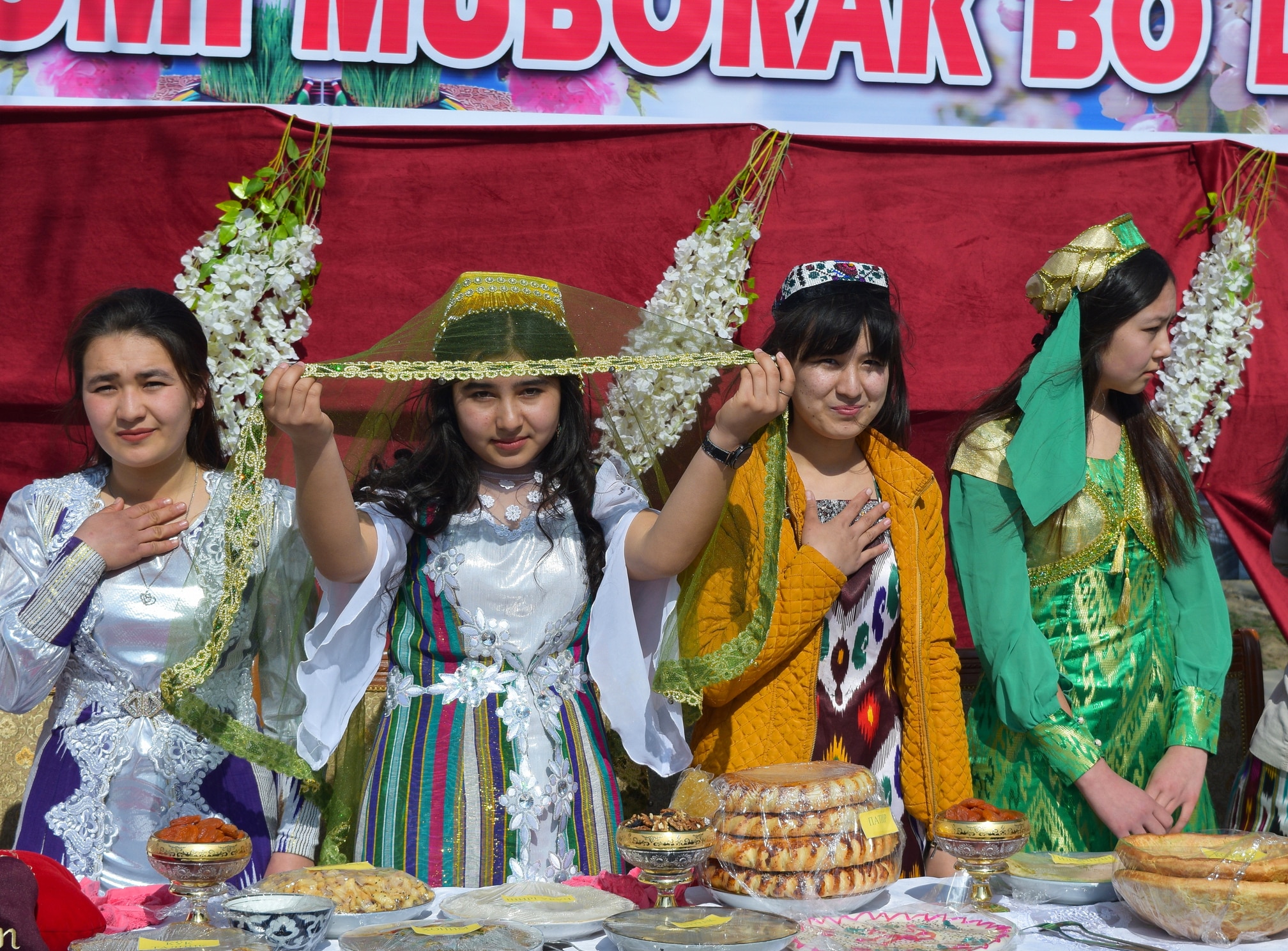
Navruz, Nooruz, Nowruz: The Ancient Spring New Year of Central Asia
Navruz is a spring solstice celebration that marks the beginning of the New Year according to the traditional Persian calendar. It has been a beloved holiday for some 3,000 years, surviving cultural change caused by centuries of tumultuous history. It was once celebrated on the vernal equinox but is now celebrated on the set date […]

